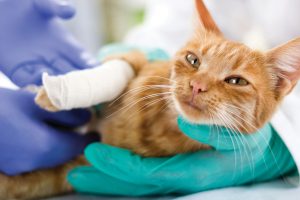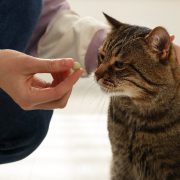Definitive Glasgow acute pain scale for cats: validation and intervention level
Definitive Glasgow acute pain scale for cats: validation and intervention level

Requires membership/payment
In our edition of: Aug 2017
In our categories of: small animals
our summary:
Reid, J. et al. (2017) Definitive Glasgow acute pain scale for cats: validation and intervention level. Veterinary Record, 180 (18), pp. 449-452
The ability to consistently assess pain in animals is vital for the management of analgesia. A number of assessment tools, where the scores are linked to an intervention level, have been developed to assist with this, most notably the Glasgow composite measure pain scale (GCMPS) for dogs which is widely used in practice.
Assessing pain in cats is always challenging, and this is made harder in clinical settings as it is complicated by the stress experienced by a cat when attending a veterinary practice. The previously reported feline composite measure pain scale (rCMPS-F) provided some evidence in this area but its sensitivity was moderate with a reported 26.7% misclassification. To enhance this tool a simple three-point facial recognition scale was later developed with the intention of embedding it within the
rCMPS-F.
This study describes a single, multi-centre study designed to:
- assess the validity of the combined tool, the CMPS-Feline, which incorporates both the rCMPS-F and the facial recognition scales, and to;
- derive an intervention-level score for analgesia.
In total 119 cats that had any acutely painful trauma or medical condition, were undergoing post-operative care, or had been admitted for surgery at one of nine centres were recruited. All cats were scored by a veterinary nurse/technician using the CMPS-Feline. Thereafter a veterinary surgeon, blinded to the CMPS-Feline score, answered the question ‘Do you think this animal requires analgesia: Yes/No?’
Results showed a modest but significant improvement in the misclassification rate when compared to the rCMPS-F – 17.6% compared to 26.7% – with the intervention level set at a score of 5 (out of a possible maximum of 20).
An editorial in the same issue of the Veterinary Record discusses the value of this new tool for practitioners, whilst emphasising the need to understand the advantages and limitations of this type of approach to pain assessment. The editorial also challenges the authors to investigate how the tool would perform with a larger population of cats experiencing different sources and types of pain.
The CMPS-Feline (https://www.newmetrica.com/acute-pain-measurement/) is a valuable assessment tool for practitioners to use alongside their clinical judgement when assessing pain in cats. When using the tool practitioners should be aware of external factors, e.g. noisy environments, which may prevent cats expressing normal behaviour and therefore influence the results.
Image copyright attribute: pyotr / 123RF Stock Photo
Join the discussion
We welcome all constructive comments and discussions. Please include the hashtag(s) below to ensure all comments can be displayed below and enable wider participation







Leave a Reply
Want to join the discussion?Feel free to contribute!